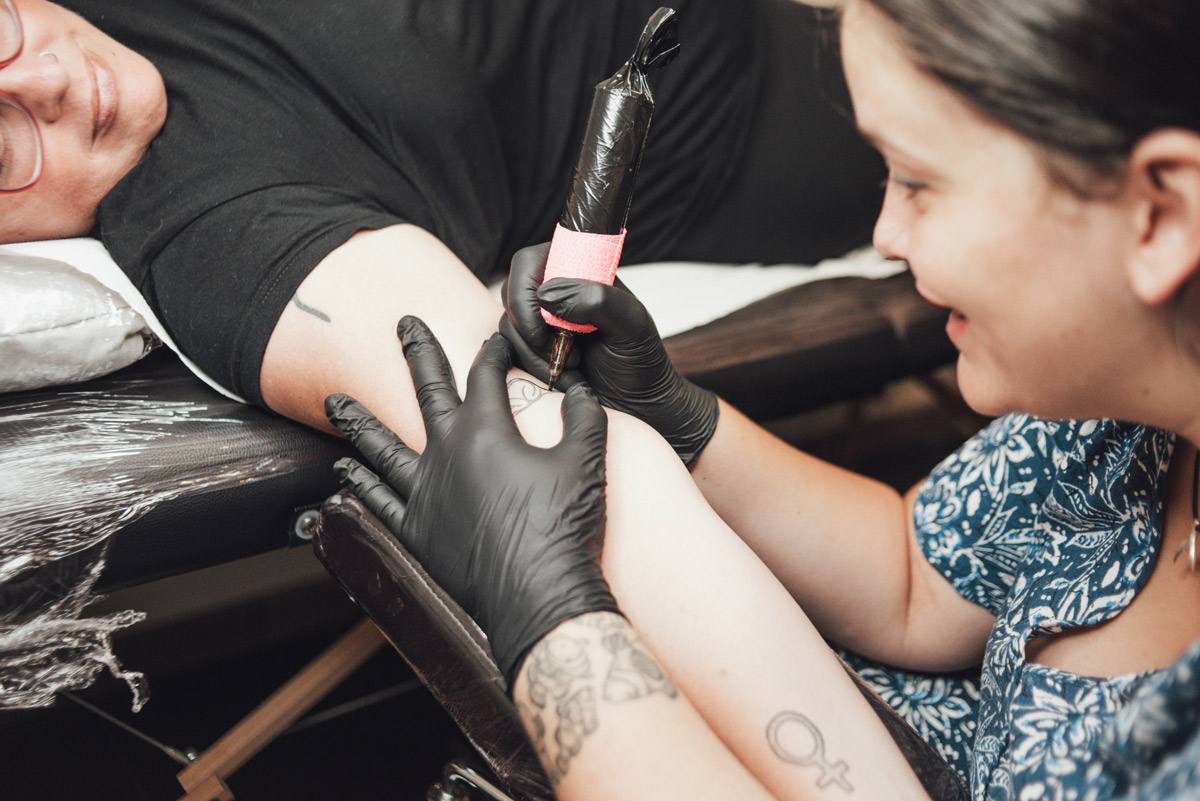
When and how did she choose to be a tattoo artist? I lived in South America and worked in marketing. I met Jorge in Chile and fell in love. Months later, we started tattooing with an open study. The experience was very bad, nobody understood that that moment was important
to us. I left that studio and told Jorge at the door, "Jorge, I'll be a tattoo artist to tattoo love stories." In the Chilean capital, Santiago de Compostela, I saw that there was an interesting course, there I started and until today.
Her second daughter, Gea, died a few minutes after birth in March 2020. The pandemic exploded ten days later. Hard times, right? When
Gea died, my life was completely paralyzed. Ten days later came the lockdown and I remember perfectly, in front of television, the moment we saw the news. The truth is that for me the pandemic was a gift: it allowed us to be together with the older son and the couple. George had paternity leave, we put a hammock in the yard and lived quiet. In those weeks when the world stayed, we started to track our wound well, without anyone coming home and putting that pressure on them. It was essential to start a better mourning. Then, gradually, I started looking for answers to the questions and that also helped me. But that initial moment, the grief, was to me golden.

It's in this context that you created the Gea project. How did it happen?
A month after
our daughter's death, I asked Jorge for help. I have several family members tattooed on my arm and I also wanted to do Gea. George helped me tattoo, but I got really sick, because I was crying while I was doing the tattoo. I soon saw that drawing on the skin was healing, so I decided to create the project. I would give tattoos to the faimlies who were in the duel.
Report and do. What welcome has Gea had? Beautiful. Over 300 families have
already gone through our study. They pay for the study and the material, and I give them my job. The project has now expanded and care goes beyond the tattoo, we give them emotional support from the very beginning, both in childbirth and in the first days of the hospital.
How do you work? Tattoos are much
more for me than tattoos: I turn memories into illustrations and imagine them forever on people's surfaces. We work very hard.
If I also need 30 minutes to do my job, we make a two-hour appointment. So we have the opportunity to meet and dialogue with the family, and I like to work with them the final touches of the illustration to be content with the result. I am very proud of what we do.
Death is taboo. Does the system prepare us to fire a child forever? Nobody prepares us, because the natural thing is to kill us before our children. There is a lack of education and it should be
normalized. In fact, one in four pregnancies is a perinatal death according to WHO data. So it's not that rare. And not only that, in pregnancy, it's not all pink: it's possible, as we did, for us to diagnose heart disease to your baby during pregnancy, and for that we also have to be prepared to ask for help.

Perinatal grief is also a great taboo. What would you tell a family that a baby has died and the people around him? Often,
a hug is worth more than a word. Because when a child dies to us, it goes without saying anything. Moreover, the pain is so terrible that there is nothing to say, there are no words that cure it. The best thing they can do is give space to the experience lived by that family, take the food and go for a walk if they have a dog, ask about the name of the child and point the date of birth. Society remains as if they do not exist frequently, but dialogue with them helps.
Finally, do you think motherhood is idealized? How did you anticipate being a mother? From a young age, I knew I wanted to be
a mother. That's why I've traveled a lot. I'm proud of everything I've done before I become a mother. I represented motherhood as an easy thing. I thought we would be nomads and we would live working there and here. Then I saw no. Our third child underwent heart surgery at birth, so we can't travel long enough.
"Art has always been present in my life. My mother was an art collector and she is currently performing painting exhibitions; my father is the best cartoonist I know. My sister and I, when we were little, took us to exhibitions and art galleries. He always said that around us there was beauty and that we too would be able to create beauty. Today this lasts me time and time again. But parents never saw art as a possible trade, neither tried nor promoted me academically. They said it was a hobby. Then I found myself casually with tattoos, but I think everything was written somewhere."